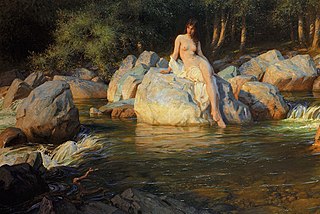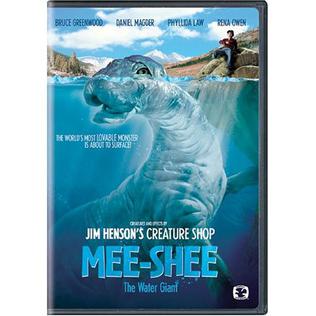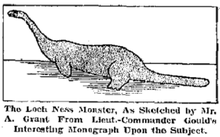
The Loch Ness Monster, affectionately known as Nessie, is a creature in Scottish folklore that is said to inhabit Loch Ness in the Scottish Highlands. It is often described as large, long-necked, and with one or more humps protruding from the water. Popular interest and belief in the creature has varied since it was brought to worldwide attention in 1933. Evidence of its existence is anecdotal with a number of disputed photographs and sonar readings.

A kelpie, or water kelpie, is a shape-shifting spirit inhabiting lochs in Irish and Scottish folklore. It is usually described as a black horse-like creature, able to adopt human form. Some accounts state that the kelpie retains its hooves when appearing as a human, leading to its association with the Christian idea of Satan as alluded to by Robert Burns in his 1786 poem "Address to the Devil".
Lake Tianchi Monster is the name given to what is said to be a lake monster that lives in Heaven Lake located in the peak of Baekdu Mountain within the Baekdu-daegan and Changbai mountain ranges encompassing Jilin Province of China and Ryanggang Province of North Korea. According to Beijing Youth Daily, an estimated 20 monsters were reported, however "scientists are skeptical that any large creature would be able to survive in the lake given its recent history of volcanic activity", and skeptics say "it's all in the imagination, or just a floating volcanic rock".

In Canadian folklore, the Ogopogo is a lake monster said to inhabit Okanagan Lake in British Columbia, Canada. Some scholars have charted the entity's development from First Nations folklore and widespread water monster folklore motifs. The Ogopogo now plays a role in the commercial symbolism and media representation of the region.

Scottish mythology is the collection of myths that have emerged throughout the history of Scotland, sometimes being elaborated upon by successive generations, and at other times being rejected and replaced by other explanatory narratives.

Jon-Erik Beckjord was an American paranormal investigator, photographer, and cryptozoologist interested in UFOs, crop circles, the Loch Ness Monster, and Bigfoot. Throughout his life, he owned three separate, small-scale museums that featured displays, mostly photographs, of alleged UFO, Nessie, and Bigfoot sightings. He made guest appearances on national radio and television shows, but was criticized by skeptics and fellow cryptozoologists alike for not providing substantive evidence to back up his claims of the existence of paranormal beings.

Joe Nickell is an American skeptic and investigator of the paranormal.

In American folklore, Champ or Champy is the name of a lake monster said to live in Lake Champlain, a 125-mile (201 km)-long body of fresh water shared by New York and Vermont, with a portion extending into Quebec, Canada. The legend of the monster is considered a draw for tourism in the Burlington, Vermont and Plattsburgh, New York areas.

Rupert Thomas Gould was a lieutenant-commander in the British Royal Navy noted for his contributions to horology. He was also an author and radio personality.

In Canadian folklore, Memphre is a lake monster said to live in Lake Memphremagog, a fresh water glacial lake located between Newport, Vermont, United States and Magog, Quebec, Canada.

Benjamin Radford is an American writer, investigator, and skeptic. He has authored, coauthored or contributed to over twenty books and written over a thousand articles and columns on a wide variety of topics including urban legends, unexplained mysteries, the paranormal, critical thinking, mass hysteria, and media literacy. His book, Mysterious New Mexico: Miracles, Magic, and Monsters in the Land of Enchantment, was published in the summer of 2014 and is a scientific investigation of famous legends and folklore in the state of New Mexico. In 2016 Radford published Bad Clowns, a 2017 IPPY bronze award winner, and he is regarded as an expert on the bad clowns phenomenon.

Mee-Shee: The Water Giant is a British-German family film shot in New Zealand in 2002 and released in 2005. It stars Bruce Greenwood, Rena Owen, Tom Jackson and Daniel Magder.
In Lake Tahoe folklore, Tahoe Tessie is a creature which resides in North America's largest alpine lake, Lake Tahoe, located in Nevada and California. It is said to live in an underwater tunnel that is beneath Cave Rock. Founder of the University of California, Davis's Tahoe Research Group Charles R. Goldman attributes claimed sightings to pareidolia and the mistaken identification of a large breed of fish introduced to Lake Tahoe during trout and mackinaw plantings. The talk of Tessie is similar to the Loch Ness monster "Nessie".

A water horse is a mythical creature, such as the Ceffyl Dŵr, Capaill Uisce, the bäckahäst and kelpie.

In Canadian folklore, Cressie is the nickname given to an eel-like lake monster said to reside in Crescent Lake, Robert's Arm, Newfoundland and Labrador, Canada. The name is a portmanteau of Crescent Lake and Nessie, the nickname given to the Loch Ness Monster. The monster has been described as resembling a large dark brown eel around 15 feet in length with a long, sleek body and as "looking long and shiny, and having a fish-like head." Claims of Cressie being sighted began in the 1950s, and continue to the present day.

In Canadian folklore, the Igopogo is a mythical creature said to dwell in Lake Simcoe, Ontario. The creature's name is ostensibly based on the Ogopogo, of Lake Okanagan, British Columbia, and also the title of the 1952 book I Go Pogo, a slogan often mentioned in the comic. Other nicknames for the Igopogo include Beaverton Bessie, after Beaverton, Ontario, and "Kempenfelt Kelly" after the bay that extends from the lake into the city of Barrie, Ontario. The city of Barrie erected a sculpture of the Igopogo at the waterfront.
In West Virginian folklore, the Mothman is a humanoid creature reportedly seen in the Point Pleasant area from November 15, 1966, to December 15, 1967. The first newspaper report was published in the Point Pleasant Register, dated November 16, 1966, titled "Couples See Man-Sized Bird ... Creature ... Something". The national press soon picked up the reports and helped spread the story across the United States. The source of the legend is believed to have originated from sightings of out-of-migration sandhill cranes or herons.













